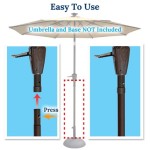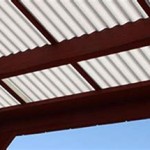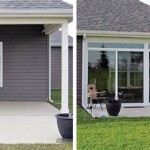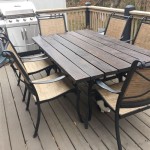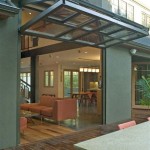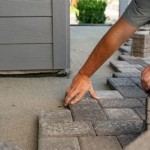```html
Outdoor Patio and Kitchen: Defining the Al Fresco Living Space
The outdoor patio and kitchen represent a significant extension of living space, blurring the lines between the indoors and outdoors. This integration provides homeowners with opportunities for relaxation, entertainment, and culinary experiences in the fresh air. Careful planning and execution are crucial to creating a functional and aesthetically pleasing outdoor environment that complements the existing architecture and enhances the overall property value. Considerations involve layout, materials, utilities, appliances, and local building codes. The successful combination of these elements transforms a simple backyard into a versatile and inviting area for socializing and enjoying the natural surroundings.
The concept of outdoor living has evolved significantly. Originally, a simple barbecue grill and a picnic table might have sufficed. Today's outdoor kitchens incorporate sophisticated appliances such as built-in grills, smokers, pizza ovens, refrigerators, and even dishwashers. Patios are no longer just concrete slabs; they are carefully designed spaces featuring comfortable seating arrangements, fire pits, and integrated lighting. The evolution reflects a desire to expand the comforts of home into the outdoor environment, allowing homeowners to fully utilize their property and engage in a more relaxed and nature-oriented lifestyle.
Key Point 1: Planning and Design Considerations
Effective planning is paramount to a successful outdoor patio and kitchen project. This stage involves assessing the available space, considering the desired functionality, and establishing a clear budget. Factors such as prevailing winds, sun exposure, and proximity to the main house should be carefully evaluated to optimize the layout and ensure comfort. A well-designed outdoor kitchen minimizes unnecessary trips back inside the house, improving efficiency and allowing the host to remain engaged with guests.
Space assessment involves measuring the intended area and considering any existing landscaping features. The desired functionality dictates the types of appliances and features to be included. A comprehensive budget should account for materials, labor, appliances, permits, and potential unexpected costs. Prioritizing essential elements and making informed decisions about optional features are crucial for staying within budget. Detailed design plans, including layout diagrams and material specifications, are highly recommended to ensure a clear understanding of the project scope and facilitate communication with contractors.
Wind direction plays a significant role in determining the placement of the grill or smoker. Smoke should ideally be directed away from the seating area and the house to minimize discomfort and potential fire hazards. Sun exposure influences the choice of shade structures, such as pergolas, awnings, or umbrellas. Proximity to the house affects the ease of access to utilities, such as water and electricity. Careful consideration of these factors leads to a more enjoyable and functional outdoor living space.
Key Point 2: Material Selection and Durability
The selection of durable and weather-resistant materials is essential for ensuring the longevity and aesthetic appeal of the outdoor patio and kitchen. Materials must withstand exposure to the elements, including sun, rain, snow, and temperature fluctuations. Common materials include natural stone, concrete pavers, composite decking, stainless steel, and treated lumber. Each material offers unique characteristics in terms of appearance, cost, and maintenance requirements. Making informed choices based on local climate and aesthetic preferences is crucial.
Natural stone, such as granite, slate, and flagstone, offers a timeless and elegant aesthetic. It is highly durable and resistant to weathering, but can be more expensive than other options. Concrete pavers are a versatile and cost-effective alternative, available in a wide range of colors, shapes, and textures. Composite decking provides the look and feel of wood without the maintenance requirements, as it is resistant to rot, insects, and fading. Stainless steel is the preferred material for outdoor kitchen appliances due to its durability, corrosion resistance, and ease of cleaning.
Treated lumber is often used for framing and structural elements. The treatment process protects the wood from rot and insect damage. Proper sealing and finishing are essential for maintaining the appearance and extending the lifespan of wood surfaces. Regular cleaning and maintenance are also important for preserving the beauty and functionality of all outdoor materials. This includes removing debris, washing surfaces, and reapplying sealants or finishes as needed. Proper material selection and maintenance minimize the need for costly repairs or replacements in the long run.
Key Point 3: Appliance Integration and Functionality
The integration of appliances into the outdoor kitchen design requires careful consideration of functionality, safety, and aesthetics. The choice of appliances depends on the homeowner's cooking style and entertainment needs. Common appliances include grills, smokers, pizza ovens, refrigerators, sinks, and side burners. Proper ventilation, electrical connections, and plumbing are essential for safe and efficient operation. Ergonomic design principles should be applied to ensure a comfortable and functional cooking space.
Grills are the centerpiece of most outdoor kitchens. Choosing the right grill depends on factors such as fuel type (gas, charcoal, or electric), size, and features. Smokers allow for slow-cooking meats and achieving a rich, smoky flavor. Pizza ovens provide a unique cooking experience and are ideal for entertaining. Refrigerators keep beverages and perishable ingredients cold and readily accessible. Sinks facilitate food preparation and cleanup. Side burners provide additional cooking surfaces for sauces or side dishes.
Proper ventilation is crucial for removing smoke and fumes from the cooking area. This can be achieved through a range hood or strategic placement of the grill in an open area. Electrical connections must be installed by a qualified electrician and comply with local building codes. Plumbing should be properly insulated to prevent freezing in cold climates. Ergonomic design principles involve positioning appliances and countertops at comfortable heights and ensuring adequate workspace. A well-designed and integrated outdoor kitchen enhances the cooking experience and allows the homeowner to fully enjoy the outdoor living space.
Lighting plays a crucial role in creating ambiance and ensuring safety in the outdoor patio and kitchen. Ambient lighting provides general illumination for the entire space. Task lighting focuses on specific areas, such as the cooking surface or dining table. Accent lighting highlights architectural features or landscaping elements. Low-voltage LED lighting is a popular choice due to its energy efficiency and long lifespan. Strategic placement of lighting fixtures enhances the functionality and aesthetic appeal of the outdoor living space.
Finally, consider incorporating features that enhance the comfort and enjoyment of the outdoor space. These might include comfortable seating arrangements, such as lounge chairs, sofas, or dining sets. Shade structures, such as pergolas, awnings, or umbrellas, provide protection from the sun. Fire pits or outdoor fireplaces create a warm and inviting atmosphere. Sound systems allow for enjoying music or podcasts while relaxing or entertaining. Creature comforts such as insect repelling fans or misting systems can add another layer of usability.
```
What To Know About Adding An Outdoor Kitchen

Outdoor Kitchen Dallas Tips For Planning Your I Compass Design
Outdoor Kitchen Built In Grills Fridge Grill Islands 9 Trees Landscape Construction

7 Outdoor Kitchen Ideas For Homeowners

Outdoor Patio Design Ideas Best Kitchen Layouts

25 Outdoor Kitchen Ideas Creative For Kitchens

5 Simple Outdoor Kitchen Ideas All Terrain Landscaping Co

Enhance Your Outdoor Living Experience With A Patio Kitchen

16 Outdoor Kitchen Design Ideas And S Alfresco Styles

75 Outdoor Kitchen Design Ideas

